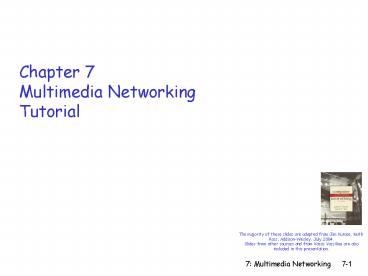Chapter 7 Multimedia Networking Tutorial PowerPoint PPT Presentation
1 / 15
Title: Chapter 7 Multimedia Networking Tutorial
1
Chapter 7Multimedia Networking Tutorial
The majority of these slides are adapted from Jim
Kurose, Keith Ross, Addison-Wesley, July
2004.Slides from other sources and from Vasos
Vassiliou are also included in this presentation.
2
Chapter 7 outline
- 7.1 Multimedia Networking Applications
- 7.2 Streaming stored audio and video
- 7.3 Real-time Multimedia Internet Phone case
study - 7.4 Protocols for Real-Time Interactive
Applications - RTP,RTCP,SIP
- 7.5 Distributing Multimedia content distribution
networks
- 7.6 Beyond Best Effort
- 7.7 Scheduling and Policing Mechanisms
- 7.8 Integrated Services and Differentiated
Services - 7.9 RSVP
3
Real-time interactive applications
- Going to now look at a PC-2-PC Internet phone
example in detail
- PC-2-PC phone
- instant messaging services are providing this
- PC-2-phone
- Dialpad
- Net2phone
- videoconference with Webcams
4
Interactive Multimedia Internet Phone
- Introduce Internet Phone by way of an example
- speakers audio alternating talk spurts, silent
periods. - 64 kbps during talk spurt
- pkts generated only during talk spurts
- 20 msec chunks at 8 Kbytes/sec 160 bytes data
- application-layer header added to each chunk.
- Chunkheader encapsulated into UDP segment.
- application sends UDP segment into socket every
20 msec during talkspurt.
5
Internet Phone Packet Loss and Delay
- network loss IP datagram lost due to network
congestion (router buffer overflow) - delay loss IP datagram arrives too late for
playout at receiver - delays processing, queueing in network
end-system (sender, receiver) delays - typical maximum tolerable delay 400 ms
- loss tolerance depending on voice encoding,
losses concealed, packet loss rates between 1
and 10 can be tolerated.
6
Delay Jitter
constant bit
rate transmission
Cumulative data
time
- Consider the end-to-end delays of two consecutive
packets difference can be more or less than 20
msec
7
Internet Phone Fixed Playout Delay
- Receiver attempts to playout each chunk exactly q
msecs after chunk was generated. - chunk has time stamp t play out chunk at tq .
- chunk arrives after tq data arrives too late
for playout, data lost - Tradeoff for q
- large q less packet loss
- small q better interactive experience
8
Fixed Playout Delay
- Sender generates packets every 20 msec during
talk spurt. - First packet received at time r
- First playout schedule begins at p
- Second playout schedule begins at p
9
Adaptive Playout Delay, I
- Goal minimize playout delay, keeping late loss
rate low - Approach adaptive playout delay adjustment
- Estimate network delay, adjust playout delay at
beginning of each talk spurt. - Silent periods compressed and elongated.
- Chunks still played out every 20 msec during talk
spurt.
Dynamic estimate of average delay at receiver
where u is a fixed constant (e.g., u .01).
10
Adaptive playout delay II
Also useful to estimate the average deviation of
the delay, vi
The estimates di and vi are calculated for every
received packet, although they are only used at
the beginning of a talk spurt. For first packet
in talk spurt, playout time is
where K is a positive constant. Remaining
packets in talkspurt are played out periodically
11
Adaptive Playout, III
- Q How does receiver determine whether packet is
first in a talkspurt? - If no loss, receiver looks at successive
timestamps. - difference of successive stamps gt 20 msec --gttalk
spurt begins. - With loss possible, receiver must look at both
time stamps and sequence numbers. - difference of successive stamps gt 20 msec and
sequence numbers without gaps --gt talk spurt
begins.
12
Recovery from packet loss (1)
- forward error correction (FEC) simple scheme
- for every group of n chunks create a redundant
chunk by exclusive OR-ing the n original chunks - send out n1 chunks, increasing the bandwidth by
factor 1/n. - can reconstruct the original n chunks if there is
at most one lost chunk from the n1 chunks
- Playout delay needs to be fixed to the time to
receive all n1 packets - Tradeoff
- increase n, less bandwidth waste
- increase n, longer playout delay
- increase n, higher probability that 2 or more
chunks will be lost
13
Recovery from packet loss (2)
- 2nd FEC scheme
- piggyback lower quality stream
- send lower resolutionaudio stream as
theredundant information - for example, nominal stream PCM at 64 kbpsand
redundant streamGSM at 13 kbps.
- Whenever there is non-consecutive loss,
thereceiver can conceal the loss. - Can also append (n-1)st and (n-2)nd low-bit
ratechunk
14
Recovery from packet loss (3)
- Interleaving
- chunks are brokenup into smaller units
- for example, 4 5 msec units per chunk
- Packet contains small units from different chunks
- if packet is lost, still have most of every chunk
- has no redundancy overhead
- but adds to playout delay
15
Summary Internet Multimedia bag of tricks
- use UDP to avoid TCP congestion control (delays)
for time-sensitive traffic - client-side adaptive playout delay to compensate
for delay - server side matches stream bandwidth to available
client-to-server path bandwidth - chose among pre-encoded stream rates
- dynamic server encoding rate
- error recovery (on top of UDP)
- FEC, interleaving
- retransmissions, time permitting
- conceal errors repeat nearby data

